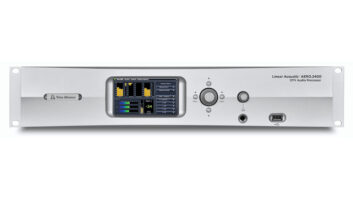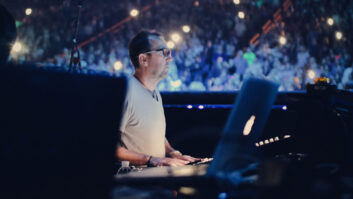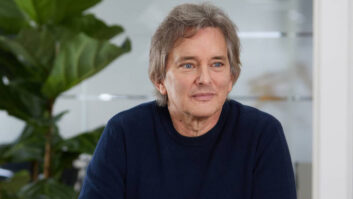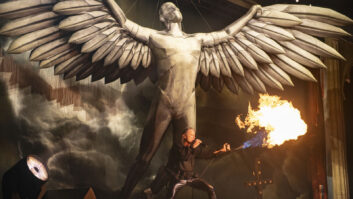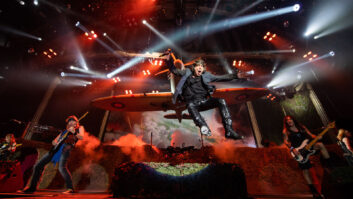It’s a measure of just how far Aerosmith has left behind its image as ’70s bad boys that they were asked to be part of this year’s Super Bowl half-time festivities, and that they staged an abbreviated Battle of the Bands there with none other than squeaky clean teen icons ’N Sync, and romped around with the likes of Britney Spears, Mary J. Blige and Nelly. There was Steven Tyler, still the energetic, rubber-lipped dynamo, dragging his trusty microphone stand around the stage with the same enthusiasm he had 25 years ago, shadowed step for step by the ever-dependable, guitar-slinger Joe Perry, who tossed off crunching power chords with effortless grace. Wait a second — what year is this? At this point, Aerosmith is more than just a band — they’re an American institution. It is, as Jerry Garcia once said of the Grateful Dead, “like the town whore that’s finally become respectable.”
This is a group that understands its fans and its legacy, that never strays too far from what’s expected of them, yet has managed to update its sound in subtle ways so they always seem current. All the critics’ “dinosaur” jokes bounce off of them like bullets fired at Godzilla, because, year after year, Aerosmith delivers — on the road and in the studio. They love being Aerosmith — they wave that freak flag high — and they’re seriously dedicated to keeping the experience fresh for themselves and their legions of fans. And part of doing that is taking the time to make albums they’re proud of. Their latest is called Just Push Play, and like most of the Aerosmith records that preceded it, it offers up a blend of testosterone-fueled hard rock songs, gripping power ballads and grandiose productions that straddle several different moods at once. There are a couple of tunes with sweeping strings, but there are also ones with loops and other modern touches. Say what you will about them; they are not complacently standing still.
Just Push Play is the first Aerosmith album to be recorded almost entirely in home studios — Joe Perry’s fabulously well-equipped basement, known as The Boneyard, and Steven Tyler’s nearby barn studio, The Bryer Patch. It is also the first Aerosmith CD to use Pro Tools as the sole multitrack recording medium. The band didn’t set out to work this way when they began pre-production in the fall of 1999 — they had always worked well in conventional top-level studios. But as the project evolved over time, Perry, Tyler and their outside producer cohorts, Marti Frederiksen and long-time ally Mark Hudson, came to love the comfort and convenience of working at home, and the flexibility and dependability of hard disk recording. That more and more top-level bands are working this way is sobering news for professional recording studios, but equipment manufacturers and dealers should be doing cartwheels — these “home studios” are stacked floor to ceiling with the latest gear, as well as fine vintage pieces.
“I’ve had a studio since I moved into this house 11 years ago,” says Perry, who, like the others bandmembers, lives in the Boston area. “As with most project studios, it started off as a hobby years ago, with a cassette. In the ’70s, I was the only one in the band that had a studio. Then I got an AudioTronics board and a Scully 1-inch machine and an 8-track. Later, I made the jump to an Allen & Heath 24-bus and an Otari 24-track. My main motivation through the years, aside from having a place where we could do demos, was to have a place where I could fly guitar solos over from. I always wanted to make sure that it would sound as good as it could sound, and it would be technically strong enough to use — whether it was guitar or Steven’s vocal. So I worked really closely with Perry Margouleff to build the studio here. It’s been in three different parts of my basement. I got rid of the Allen & Heath, and I found this old Neve 8068 board at WGBH [in Boston] and Perry [Margouleff] reworked it from the ground up and made this 8-bus board into a 32. George Augspurger came down and tuned the room. It got to where the demos we were working on here started sounding so good that finally we just said, ‘Let’s do it here.’”
The band’s previous CD, Nine Lives (released in 1997) was essentially cut twice — once at Criteria in Miami using ADATs and then re-recorded at Avatar in New York on conventional multitrack. The band had no interest in repeating that experience, though when writing sessions for the new record began, there was no real plan in place.
“We didn’t really have any regular demos for this record,” Perry says. “We were writing as we went along; the four of us — me and Steven and Marti Frederiksen and Mark Hudson. We might start with a drum loop or a rhythm track in Pro Tools, or on other songs we’d start with acoustic guitars. Probably half the songs were written on acoustic guitars, and we’d track with a loop or whatever. Then we’d put a rough drum track on here at my studio, just to get a vibe. And then from there we’d start layering. So the songs had a cohesiveness and a vibe to them at the end of the day.”
“What we really did was take our demos and turn them into the record,” adds Frederiksen, who had songwriting but no production credit on Nine Lives. “When we approached each song, it was like it was going to be on the finished record. With that in mind, we had the attitude that we were actually doing the record while we were writing, and we weren’t going to redo everything later.” Frederiksen says that when they were writing songs, “we were making sure that we were covering all the bases — some rock songs, some pop songs. I think we really nailed it this time.” Perry says that one of the things he likes about Frederiksen is that the drummer/guitarist/vocalist brings a younger and hipper attitude to his writing — “He’s from the Pro Tools generation,” Perry jokes — but Frederiksen is quick to point out, “I didn’t want to make them something they’re not. I wanted to incorporate a fresh vibe for them, not change what they are.”
Once the decision was made to keep building from the demos, recording everything in Pro Tools and working primarily at The Boneyard and The Bryer Patch, a Pro Tools engineer named Richard Chycki, who had worked with Frederiksen on a Jeff Healey album project in Canada, was brought onto the recording team, which included Perry’s in-house engineer Paul Caruso, who has been with him for two-and-a-half years, and Paul Santo, who runs Tyler’s studio.
“I think there’s always been a little stigma about doing a home studio record,” Chycki says. “I think it brings to mind an image of some guy in a dank, dark basement huddled over a 4-track with some ‘mudtone’ speakers, and all that. This is not like that. This place is obscene. There’s just tons and tons of equipment at our disposal. Our slogan was ‘more!’” he laughs. “We had five or six Pro Tools systems, 160 gigs of hard drive space. Both Joe’s and Steven’s studios are amazing.”
Though he is an engineer and mixer who has unabashedly embraced Pro Tools, Chycki is well aware that until recently there has been resistance to the technology in some engineering circles. That attitude, he says, seems to be changing. “I think there were a lot of people who didn’t like Pro Tools just because it’s computer-based and was therefore intangible in some way to people used to working with recorders, where you’d see reels spinning and you’d have actual tape. But when they see how it actually is to work with and they heard the end result, particularly with the best systems now…well, it’s different than it was just a couple of years ago. Pro Tools has really come into its own.”
“The danger in Pro Tools,” Perry adds, “is things not being wide enough and getting enough air. So you need to get someone in there who knows how to work against those things. Richard’s using some of the plug-ins, and he’s using old LA-2As on other things. I think everything sounds really, really good.”
“At The Boneyard, we’ve got a desk full of Neve 1073s [preamps], and we also have some Focusrite ISA 110s and a great microphone collection,” Paul Caruso notes, “so when you combine those with the Pro Tools, it’s going to sound good. The pressure is always on to have a good chain to whatever recorder you’re using, and when it comes down to it, that’s really what Pro Tools is, a recorder that also happens to have a lot of other features. The editing, DSP, recalling of mixes and all the plug-ins made it an easy choice for us.”
“I have a beautiful, totally reworked Studer 800 Mark 3 that’s just sitting over here in the corner,” Perry says. “We never used it. We didn’t need to.”
Unlike many other Aerosmith albums where the band attempted to lay down live rhythm tracks as a group and then added vocals and solos later, on this project the drums and bass were the last things recorded and nearly every part was added separately, with each player reacting individually to what had already been put down in Pro Tools by the others. So, in effect, they built the master take of each song part by part in Pro Tools, and there is no band performance of any song.
“On the one-hand, some people might be disappointed to hear that the whole band didn’t sit in a room and play it all together like a live track,” Perry comments. “But that’s such an impractical way to do things, because, in my experience, 90 percent of the time you go in and you do that and then you end up replacing the bass, replacing the rhythm guitars, and you’re just trying to get a good drum track. When you think about it, what better way for the drummer to play to a song than to hear a song that’s got guitars that are keepers and vocals that are keepers? It’s like playing along with the band live, for real.”
Drummer Joey Kramer and bassist Tom Hamilton had a wait of several months before their contributions were added to the songs; first, Perry, rhythm guitarist Brad Whitford and Tyler methodically laid in their parts. Perry prides himself on coming up with different guitar textures from song to song, and this album was no exception. “It might have even more [different guitars] on it than usual, because we did them at The Boneyard,” he notes. “There are acoustic guitars on a lot of songs. For electric, I might go for a clean Tele into a Twin kind of sound or a highly overdriven rock thing. Since we record here, I don’t have to cart my entire collection around, which I never do anyway. You usually just pick a few you know you’re going to use. But here I have every guitar that I would ever want, and some that I don’t, down here at our disposal. There are probably about 50 guitars out of the cases at any given time, and a lot of other things that have strings on ’em. I’ve got a Vox mandoguitar and a pedal steel and all sorts of amps. I’m a big Combo fan — I rarely use a 4×12. Maybe if we need something big and crunchy, but generally I find the smaller the amp, the easier it is to control and the sound is sometimes denser. A Royer [mic] can really handle high SPL, too.”
“We’ll switch around a lot between guitars and amps,” adds Caruso. “He’ll get out the Les Paul and put that through one amp, grab the Rick and the AC-30 and put that part on over here.” Caruso says he and Perry also experiment with different mics on the amps, but on this project, “what I used a lot was a Royer R-121 ribbon mic, which was a microphone that Fletcher [of Mercenary Audio] suggested. Joe and I both really, really liked it a lot; it became my favorite guitar mic. When we track guitars here, it’s high SPL,” he says with a chuckle. “The Royer can really handle high SPL; it gave it a wonderful quality.”
Adds Richard Chycki, “Being a guitar player myself, I love to record guitar and lots of it! Guitar setups varied from an organic single SM57 or Royer dead center cone on a combo, to an intricate array of amps, cabinets and mics with a matrix of Neumann KM86s, 87s, Royer R-121s, Shure SM57s, Sennheiser 421s and AKG D112s. I favor Neve mic preamps, or Focusrite ISAs occasionally, fed through a Pultec EQP-1AS — ‘hi end shelf’ mode on the 1AS model is awesome — with a bit of LA-2A or [Empirical Labs] Distressor, application dependent. I also used various combinations of Neumann KM84s and AKG 414 TLIIs or C-12s for acoustic guitars, often recording the acoustics in true stereo rather than double-tracking for a huge, but realistic, sonic image from the instrument.”
And though Perry mostly used amps from his extensive collection, Chycki also employed an Amp Farm plug-in here and there. “I’d say that’s my current favorite plug-in,” he notes, “though I’m really looking forward to hearing the Fairchild Bomb Factory and the Pultec Bomb Factory. But the Amp Farm sounds really good — it’s got an AC-30 in there, Twins…”
Tyler tracked many of his vocal parts at The Bryer Patch, which is equipped with Focusrite and Neve mic pre’s interfaced to his Pro Tools system. “Some of Steven’s earliest vocals were done with various Audio-Technica mics,” Caruso says. “We tried a Shure SM7 for a little while [as well as a Neumann M149], but we ended up doing a lot of work with a C-12; that was probably used more than any other mic for vocals.”
“The C-12 is one of my all-time favorite vocal mics, as it is for Marti,” notes Chycki. “It complemented Steven’s vocal texture perfectly. I also had both Joe and Steven’s studios outfitted with identical equipment chains for vocals, so the recording remained consistent no matter where the recording was done.
When it finally came time to record the drums, they went out to Longview Farm, a highly regarded studio in rural Brookfield, Mass., where the band had worked before. “It’s a really cool vibe and a big room and a Neve to track to,” Caruso says. “We wanted to get a drum sound that had a lot of ambience.” The team bypassed the studio’s tape multitrack tape recorders in favor of Pro Tools. Then Tom Hamilton’s bass part was interwoven with what was in essence a finished track.
After a couple of large string sessions at Ocean Way and the Village Recorder in Los Angeles with noted arranger David Campbell, a small-group string session at Sound Techniques in Boston, Just Push Play was ready to be mixed. Again, Perry and Tyler decided to stick close to home: “What happened was I bought my neighbor’s house,” Perry says with a laugh. “It’s one of those great old New England clapboard houses; parts of it date back to the 1680s. Around the same time that happened, we were talking to Mike Shipley about mixing the record, and he said, ‘You know, a couple of times what I’ve done with Mutt Lange is I’ve set up an SSL in a house, and we’ve had great success.’ So that’s what we did. We did some work in the house, shoring up the floors and doing some acoustical work and then bringing in an SSL 9000.” [See sidebar for more on this process.]
At the Mix House, as it was dubbed, Shipley mixed the CD from the Pro Tools tracks — which, in the case of a couple of songs that featured strings, numbered over a hundred. “The most we had was 102, with an orchestra, a full band and eight vocal tracks, all of which are used at different points in the song,” Perry says. “But really, a lot of the decisions were made as we recorded, as opposed to recording everything and then trying to sort it out at the other end. We’re big believers in walking out of the room with a rough mix that sounds as close to being done as you can get. If there’s anything you can call a demo, it’s those early, rough mixes.”
“The good thing about Pro Tools,” Chycki comments, “is you’re always in a mix of some sort. We would sit down and premix the material to some degree, because we were deciding if we wanted something to be EQ’d drastically — like if we wanted a harsh radio tone on the vocal or something, we would use a plug-in for that and then Shipley would listen to that and decide if it would fit into the mix as is, or if not, he’d create something to his own taste.” Shipley monitored the mixes on KRK E8s and Yamaha NS-10s. Peppered among the nine racks of outboard equipment were such pieces as a Fairchild limiter, UREI 1176, LA-3As, LA-2As, Roland’s Dimension D, SPX 90 and EMT plate reverbs, and many Distressors.
Little mix tweaks were still being made by Shipley back at the Mix House when the band went down to Tampa for their Super Bowl appearance the last weekend in January, but for all intents and purposes, the record was finished, and all that remained was returning the rented equipment and restoring the building to (most of) its former glory. The first single, “Jaded,” was already in radio programmers’ hands and shooting up the airplay charts. “I don’t think the record company thought we were going to give them a record for two years,” Perry says. “When we first went to them and said we wanted to produce it ourselves and we wanted to record it in our own studios, they probably thought, ‘Let them have their fun. They’ll get tired of doing this, and then we’ll bring in the big gun.’ I think we shocked them last summer when we played the first eight tracks. Then it became, ‘Let’s talk about album art.’”
With another solid CD under their belts — Perry says the song he’s proudest of is “Avant Garden,” one of the tunes with strings on it — the band was starting to think about hitting the road once again. That will involve a little more work than usual: “We have to go in and learn the songs in a way,” Perry says, “since we’ve never really played them in their finished form as a group. Frankly, I’m dreading having to go back and learn some of the solos. Some of these solos were done at two in the morning! I always have this attitude [when I’m recording] that ‘I’m just filling the space. I’ll redo it when I’m more together, or tomorrow or whatever.’ And then, inevitably, that turns out to be the best solo. I never went back and redid them. It was that way on the whole record. The performances were really strong; we didn’t redo much at all. A lot of it, I think, is because we had so much freedom in the way we worked; there wasn’t that feeling of pressure every second that you’ve gotta nail it right away.”
And though working at home allowed them to be more leisurely in certain ways, they rarely slacked off. This is a band famous for its work ethic, at least in recent years. Indeed, Caruso notes, “They love being in the studio; particularly Joe. It’s part of what they do, and they take it seriously and they’re really great at it.”
Adds Richard Chycki, “I didn’t know them before this project, but I can say they are, without a doubt, the hardest working band that I’ve worked with to date. They really want to do what they do. They really like to record. We’ll be in the studio for 14 hours, and we’ll all have a pale skin tone and everything, and Joe will come in at the end of the night and want to record some more stuff — some ideas that he has — and he’ll keep going. He just loves what he does; they all do.”
Blair Jackson is Mix’s executive editor.

